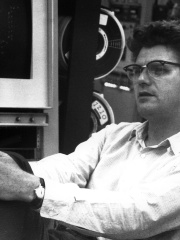
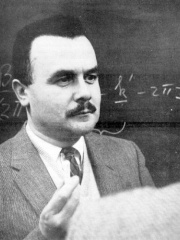
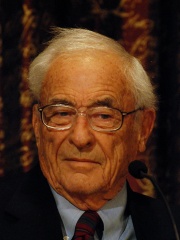
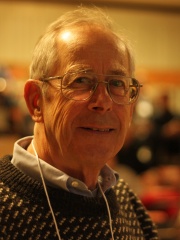

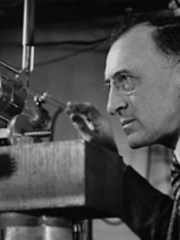


The Most Famous
PHYSICISTS from Canada
This page contains a list of the greatest Canadian Physicists. The pantheon dataset contains 851 Physicists, 10 of which were born in Canada. This makes Canada the birth place of the 16th most number of Physicists behind Ukraine, and Hungary.
Top 10
The following people are considered by Pantheon to be the top 10 most legendary Canadian Physicists of all time. This list of famous Canadian Physicists is sorted by HPI (Historical Popularity Index), a metric that aggregates information on a biography's online popularity. Visit the rankings page to view the entire list of Canadian Physicists.

1. Richard E. Taylor (1929 - 2018)
With an HPI of 72.46, Richard E. Taylor is the most famous Canadian Physicist. His biography has been translated into 64 different languages on wikipedia.
Richard Edward Taylor (2 November 1929 – 22 February 2018), was a Canadian physicist and Stanford University professor. He shared the 1990 Nobel Prize in Physics with Jerome Friedman and Henry Kendall "for their pioneering investigations concerning deep inelastic scattering of electrons on protons and bound neutrons, which have been of essential importance for the development of the quark model in particle physics."

2. Bertram Brockhouse (1918 - 2003)
With an HPI of 71.82, Bertram Brockhouse is the 2nd most famous Canadian Physicist. His biography has been translated into 62 different languages.
Bertram Neville Brockhouse, (July 15, 1918 – October 13, 2003) was a Canadian physicist. He was awarded the Nobel Prize in Physics (1994, shared with Clifford Shull) "for pioneering contributions to the development of neutron scattering techniques for studies of condensed matter", in particular "for the development of neutron spectroscopy".

3. Willard Boyle (1924 - 2011)
With an HPI of 70.09, Willard Boyle is the 3rd most famous Canadian Physicist. His biography has been translated into 65 different languages.
Willard Sterling Boyle, (August 19, 1924 – May 7, 2011) was a Canadian physicist. He was a pioneer in the field of laser technology and co-inventor of the charge-coupled device. As director of Space Science and Exploratory Studies at Bellcomm he helped select lunar landing sites and provided support for the Apollo space program. On October 6, 2009, it was announced that he would share the 2009 Nobel Prize in Physics for "the invention of an imaging semiconductor circuit – the CCD sensor, which has become an electronic eye in almost all areas of photography". He was appointed a Companion of the Order of Canada – the award's highest level – on June 30, 2010.

4. Jim Peebles (b. 1935)
With an HPI of 69.72, Jim Peebles is the 4th most famous Canadian Physicist. His biography has been translated into 60 different languages.
Phillip James Edwin Peebles (born April 25, 1935) is a Canadian-American astrophysicist, astronomer, and theoretical cosmologist who was Albert Einstein Professor in Science, emeritus, at Princeton University. He is widely regarded as one of the world's leading theoretical cosmologists in the period since 1970, with major theoretical contributions to primordial nucleosynthesis, dark matter, the cosmic microwave background, and structure formation. Peebles was awarded half of the Nobel Prize in Physics in 2019 for his theoretical discoveries in physical cosmology. He shared the prize with Michel Mayor and Didier Queloz for their discovery of an exoplanet orbiting a sun-like star. While much of his work relates to the development of the universe from its first few seconds, he is more skeptical about what we can know about the very beginning, and stated, "It's very unfortunate that one thinks of the beginning whereas in fact, we have no good theory of such a thing as the beginning." Peebles has described himself as a convinced agnostic.
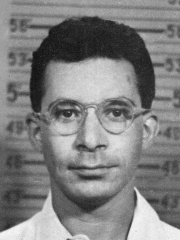
5. Louis Slotin (1910 - 1946)
With an HPI of 64.75, Louis Slotin is the 5th most famous Canadian Physicist. His biography has been translated into 25 different languages.
Louis Alexander Slotin ( SLOHT-in; 1 December 1910 – 30 May 1946) was a Canadian physicist and chemist who took part in the Manhattan Project. Born and raised in the North End of Winnipeg, Manitoba, Slotin earned both his Bachelor of Science and Master of Science degrees from the University of Manitoba, before obtaining his doctorate in physical chemistry at King's College London in 1936. Afterwards, he joined the University of Chicago as a research associate to help design a cyclotron. In 1942, Slotin was invited to participate in the Manhattan Project, and subsequently performed experiments with uranium and plutonium cores to determine their critical mass values. After World War II, he continued his research at Los Alamos National Laboratory in New Mexico. On 21 May 1946, he accidentally triggered a supercritical nuclear chain reaction, which released a burst of hard radiation. He was rushed to the hospital and died nine days later on 30 May. Slotin had become the second fatal victim of a criticality accident in history, following Harry Daghlian, who had died of a related accident with the same plutonium "demon core" the previous year. Slotin was hailed as a hero by the United States government for reacting quickly enough to prevent the deaths of his colleagues. However, some physicists argue that Slotin's behavior preceding the accident was reckless and that his death was preventable. The accident and its aftermath have been dramatized in several fictional and non-fictional accounts.

6. Donna Strickland (b. 1959)
With an HPI of 64.09, Donna Strickland is the 6th most famous Canadian Physicist. Her biography has been translated into 79 different languages.
Donna Theo Strickland (born 27 May 1959) is a Canadian optical physicist and pioneer in the field of pulsed lasers. She was awarded the Nobel Prize in Physics in 2018, together with Gérard Mourou, for the practical implementation of chirped pulse amplification. She is a professor at the University of Waterloo in Ontario, Canada. Strickland served as fellow, vice president, and president of Optica (formerly OSA), and is currently chair of its Presidential Advisory Committee. In 2018, she was listed as one of BBC's 100 Women. She has gone on to have the Natural Sciences and Engineering Research Council of Canada Prize being set in her name.

7. Arthur Jeffrey Dempster (1886 - 1950)
With an HPI of 59.18, Arthur Jeffrey Dempster is the 7th most famous Canadian Physicist. His biography has been translated into 20 different languages.
Arthur Jeffrey Dempster (August 14, 1886 – March 11, 1950) was a Canadian-American physicist best known for his work in mass spectrometry and his discovery in 1935 of the uranium isotope 235U. As part of his research, he investigated the isotopic constitution of multiple other elements.

8. Harriet Brooks (1876 - 1933)
With an HPI of 56.93, Harriet Brooks is the 8th most famous Canadian Physicist. Her biography has been translated into 21 different languages.
Harriet Brooks (July 2, 1876 – April 17, 1933) was a Canadian nuclear physicist. She is most famous for her research in radioactivity. She discovered atomic recoil, and transmutation of elements in radioactive decay. Ernest Rutherford, who guided her graduate work, regarded her as comparable to Marie Curie in the calibre of her aptitude. She was among the first persons to discover radon and to try to determine its atomic mass.

9. Paul Corkum (b. 1943)
With an HPI of 52.58, Paul Corkum is the 9th most famous Canadian Physicist. His biography has been translated into 17 different languages.
Paul Bruce Corkum (born October 30, 1943) is a Canadian physicist specializing in attosecond physics and laser science. He holds a joint University of Ottawa–NRC chair in attosecond photonics. He also holds academic positions at Texas A&M University and the University of New Mexico. Corkum is both a theorist and an experimentalist. He is known for developing the theory of attosecond physics.
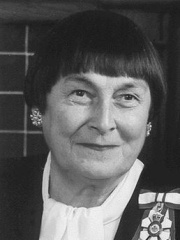
10. Sylvia Fedoruk (1927 - 2012)
With an HPI of 49.41, Sylvia Fedoruk is the 10th most famous Canadian Physicist. Her biography has been translated into 16 different languages.
Sylvia Olga Fedoruk ([Fe-doruk]; Ukrainian: Федорук) (May 5, 1927 – September 26, 2012) was a Canadian physicist, medical physicist, curler and the 17th lieutenant governor of Saskatchewan, from 1988 to 1994.
People
Pantheon has 10 people classified as Canadian physicists born between 1876 and 1959. Of these 10, 3 (30.00%) of them are still alive today. The most famous living Canadian physicists include Jim Peebles, Donna Strickland, and Paul Corkum. The most famous deceased Canadian physicists include Richard E. Taylor, Bertram Brockhouse, and Willard Boyle.
Living Canadian Physicists
Go to all RankingsJim Peebles
1935 - Present
HPI: 69.72
Donna Strickland
1959 - Present
HPI: 64.09
Paul Corkum
1943 - Present
HPI: 52.58
Deceased Canadian Physicists
Go to all RankingsRichard E. Taylor
1929 - 2018
HPI: 72.46
Bertram Brockhouse
1918 - 2003
HPI: 71.82
Willard Boyle
1924 - 2011
HPI: 70.09
Louis Slotin
1910 - 1946
HPI: 64.75
Arthur Jeffrey Dempster
1886 - 1950
HPI: 59.18
Harriet Brooks
1876 - 1933
HPI: 56.93
Sylvia Fedoruk
1927 - 2012
HPI: 49.41
Overlapping Lives
Which Physicists were alive at the same time? This visualization shows the lifespans of the 7 most globally memorable Physicists since 1700.

